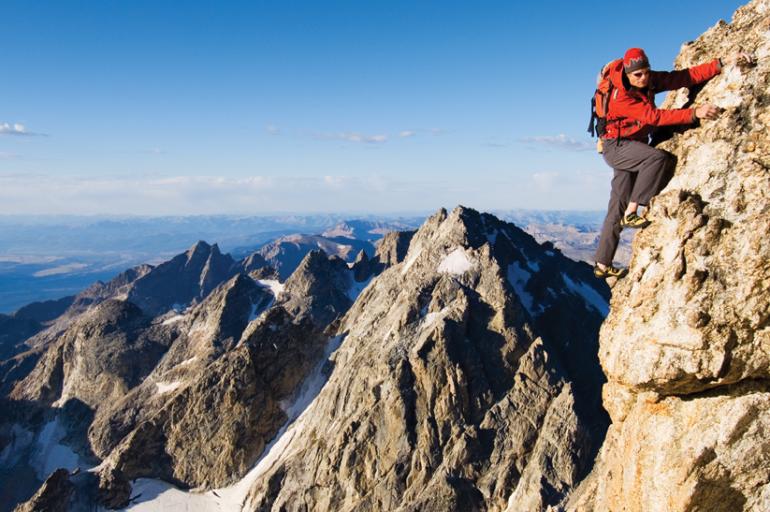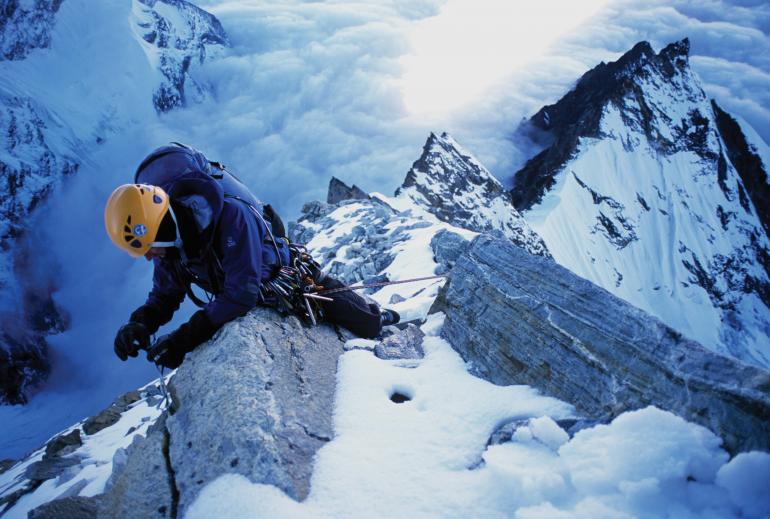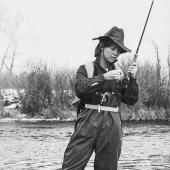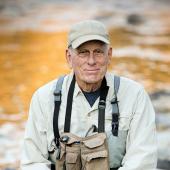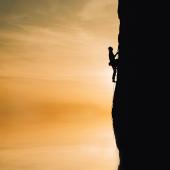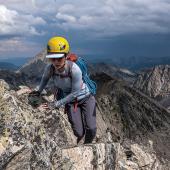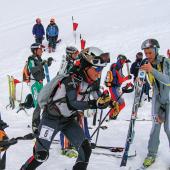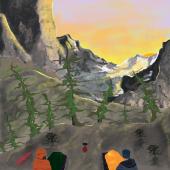Gallatin to the Ganges
After one very early morning phone call to cancel our ice-climbing plans (too warm for ice), Conrad Anker and I agreed to meet at a coffee shop and head out to some rock instead. At just a little past 8:30 on a crisp fall morning, he rolled into the parking lot on his bike, backpack bulging with climbing gear. He swung his leg over his bike seat and shot out a hand to greet me.
I was slightly surprised to meet him this way. Here before me was one of the world's most accomplished mountain climbers, a celebrity in the outdoor world who, among other things, has been the first to ascend several of the world's most treacherous peaks-many in record time. And in May of 1999, his research expedition discovered the body of George Mallory, a well-known Everest explorer who disappeared on the mountain in June of 1924. In fact, the feature film outlining the discovery of Mallory's body, starring Anker as himself, was in production.
But you wouldn't know any of this by looking at him. The 47-year-old has a tall, lean frame, a mop of blond hair riding high up his temples, and a kind, weathered face-one you can tell has spent a lot of time in the high mountains and a lot of time smiling about it. A black soft-shell jacket and stylish black-framed glasses completed his look that day, perfectly disguising him as an average Bozemanite.
"Hi, Conrad. Great to meet you," I said, gripping his outstretched hand. He gave a firm shake back and started loading his gear into my car.
"Sorry I'm late, had to help get the kids out the door, you know how it is," he said, with the exhausted fatherly tone that parents of teenagers chronically have. Filling our coffee mugs, we set off toward Gallatin Canyon.
After a few warm-up routes, we stacked the rope in front of a hard sport climb he'd never done before. I had climbed it once the previous month, very poorly, so I timidly tried to give him a few tips on the hardest part.
Right in the middle of describing the contrived crimp and sidepull sequence, I trailed off. Conrad was politely listening to me, but I could see the excitement and confidence on his face. It didn't really matter that he’d never climbed this route. I could tell what he was thinking: Thanks, but I got this. He wisely ignored my advice.
You can see Anker's gift in how he reads a route. He launched up the overhanging limestone face, moving with a certain grace that only comes with years of experience. Even at the crux, nothing seemed too hard: no hold out of reach, no foothold too small. Rock showered down on me from a broken hold, but I looked up to find him completely unaffected.
Though he'd never been on this rock before, in just a few seconds Anker had found an infinitely easier way through the difficulties I encountered, and he quietly floated to the top of the route and clipped the chains. As soon as I lowered him to the ground and he untied his knot, this enthusiastic but otherwise reserved man suddenly burst to life.
"WHOO!!! Yes!" Conrad's cheers echoed off the towering walls of the Gallatin Canyon. His emotions boiled over from the passion that has absolutely captured him for the last 30 years. "I love this! So psyched!" he shouted. He gave an enthusiastic fist-pump and turned to me, beaming. Here was a man so enamored by the challenge and beauty of the mountains that, after three decades, they could still bring him a deep, Christmas-morning grin.
I was in awe. I hope I can feel that alive, and climb that hard, at 47.
"Great climb, Conrad. Solid the whole way," I said. He looked back with a broad smile, one that had seen the peak of Everest, the South Pole, and vast expanses of unexplored mountain ranges. It was a smile not celebrating domination of the mountain, but rather of deep understanding.
Not all of Anker's climbs are as easy as floating up a wall in Gallatin Canyon. In fact, one of the climbs he's most known for ended in disaster.
On October 5, 1999, Anker's best friend, Alex Lowe, and photographer David Bridges died in an avalanche on the remote Himalayan mountain Shishapangma while the three were attempting to summit. Though seriously wounded, Anker survived and spent the next 20 hours searching for his partners.
Anker developed survivor's guilt soon after the tragedy. Even ten years later, he very clearly still struggles daily with the outcome of that fateful day. When outlining his plans for the coming week, they included "the 10th anniversary of burying my best friend."
Today, Anker is still working to make sense of what happened and is heavily involved in several charities and environmental organizations. One of his favorites is the Khumbu Climbing School, a Himalayan academy Anker and his wife, Jennifer, created.
Organized through the Alex Lowe Charitable Foundation, Khumbu works "to increase the safety margin of Nepali climbers and other high-altitude workers by encouraging responsible climbing practices through supportive and community-based programs." As the program director, Conrad provides the ideas, motivation, and organization of the group. "As a longtime climber, I’ve seen firsthand the situation the Sherpas are in," he says. "They account for a huge ratio of the fatalities in the high mountains, which is just devastating to their families and communities, so education and safety can make a huge difference."
Much closer to home, Conrad is also one of the main contributors to the Bozeman Boulder Initiative, which built two climbing boulders in parks around town (with another coming soon). "It's a really great opportunity for the community,” he explains, "introducing people to a sport they otherwise might not experience."
Anker's charitable work is now a formidable part of his life, but he hasn't abandoned mountaineering by any stretch. After our climb, I attended Anker's presentation with fellow climbing legend Jimmy Chin at the Emerson, titled "The Center of the Universe: Teamwork and Tenacity in the Himalayas." He and Chin described their more recent attempt to climb the 22,000-foot Mt. Meru, a notoriously difficult peak in northern India whose summit had eluded some of the world's best alpinists for 20 years. Accompanied by stunning pictures and videos, they outlined a journey taken with truckloads of gear to the high mountains halfway across the globe. While encountering ridiculous characters and situations, they acclimated to the elevation and planned their route at the base of the peak. After 18 long days on a mountain with frigid temps, endless snowstorms, wicked-hard climbing, and only eight days worth of food, the team had to retreat just a few hundred feet from the peak of the mountain.
"We wanted the summit so badly, but we were absolutely crushed," Anker told the crowd. "We had rationed down the food to only three tablespoons of oatmeal each for breakfast, we were running out of fuel to melt drinking water, and we would have seriously risked frostbite had we kept climbing. No matter how great it would have been, no summit is worth losing body parts."
Even when things were at their worst, Jimmy remarked, Conrad was an endless source of enthusiasm, leading all the hardest climbs and generally keeping spirits high. I smiled to myself, having personally seen him pour that same amount of determination and excitement into a route a fraction of the size.
After the presentation, fans lined up outside the noisy auditorium, all waiting impatiently to get a signed poster from Conrad and Jimmy. Starry-eyed fanboys and other Bozeman residents clamored for an autograph, and I had to remind myself that I'd recently climbed and hung out with this climbing superstar, casually chatting about local guidebooks and religion. I joined the line.
After a few minutes, it was my turn. "Hi Conrad! Great presentation," I said, holding out my hand. He stared at me blankly for a moment.
Great, play it up all friendly for the interview, I thought. As quickly as the words went through my mind, that familiar, old-friend smile exploded over his face and he enthusiastically grabbed my hand. “Right! From the magazine! Hi, how’ve you been?" He turned to introduce me to Jimmy. "This is the guy I was telling you about,” he said. We chatted a while, and made plans to go ice climbing together when he got back from his upcoming North Face tour.
I walked away, beaming with a stupid grin on my face. The poster bore an apt inscription: "With inspiration, Conrad."


